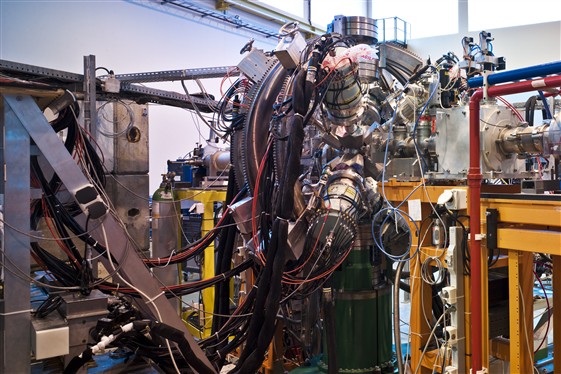ISOLDE steps up a gear
The High Intensity and Energy ISOLDE project (HIE-ISOLDE), an important upgrade of the ISOLDE facility, was approved at the Research Board’s December meeting. Thanks to a new superconducting linear accelerator and an improved target installation, HIE-ISOLDE will be able to provide higher energy and higher intensity beams to the experiments. New opportunities will open up for nuclear physics with radioactive ion beams at CERN.

A view of the Miniball experiment installed at the ISOLDE facility.
Over the years, experiments at ISOLDE have produced many valuable results in different fields, from studies of nuclear shapes to accurate measurements of parity violation, and have made important contributions to the understanding of the formation of heavy elements in explosive stellar processes. “This was possible thanks to several upgrades of the facility that took place over the years”, says Alexander Herlert, ISOLDE physics coordinator. “One of the major upgrades was the installation of REX-ISOLDE, which bunches, charge-breeds and accelerates beams after they have been produced”. In 2007, a new radiofrequency quadrupole cooler and buncher improved the emittance and time structure of the beams.
The Research Board has just approved an even more important upgrade which will increase the beam energy from 3 MeV/nucleon to 10 MeV/nucleon and should significantly improve the intensity of the radioactive beams. “With previous energies we were able to study nuclear properties through Coulomb excitation. Using this technique, the MINIBALL experiment produced many important results over the last seven to eight years”, says Yorick Blumenfeld, spokesperson of the ISOLDE Collaboration. “Thanks to HIE-ISOLDE, we will be able to study transfer reactions, in which one or more nucleons are transferred between the projectile and the target. This will open up new possibilities to understand nuclear structure over the entire nuclear chart. HIE-ISOLDE will be the only facility to post-accelerate elements as heavy as radon”.
The ISOLDE community currently comprises about 500 users. Funding for the new facility will come from both CERN and external funding agencies. The cost of the upgrade is estimated at around 36 million CHF. Under the guidance of project leader Yacine Kadi the new installation should be available for experiments in 2014.
| Did you know ? Radioactive ion beam experiments at CERN have developed and used many pioneering techniques. One is the implementation of lasers in both the production of beams and the spectroscopy of isotopes. In the first case, the accurate tuning of the laser wavelength allows very selective ionization of a specific element and thus the production of pure beams. This feature is very important for precision studies of the structure of the nucleus. Laser spectroscopy has been widely used at ISOLDE for the study of nuclear ground state properties, such as nuclear spin and charge radii. |
Further reading: ISOLDE in the CERN Courier
More technical information about HIE-ISOLDE ca be found on the ISOLDE website.

